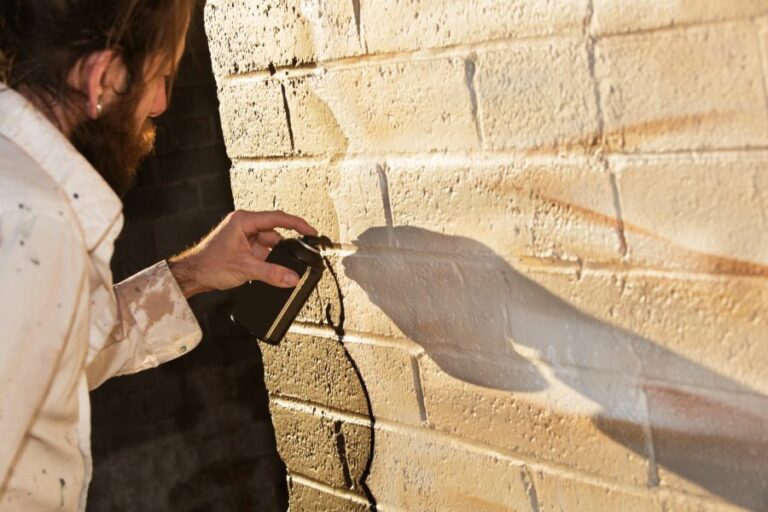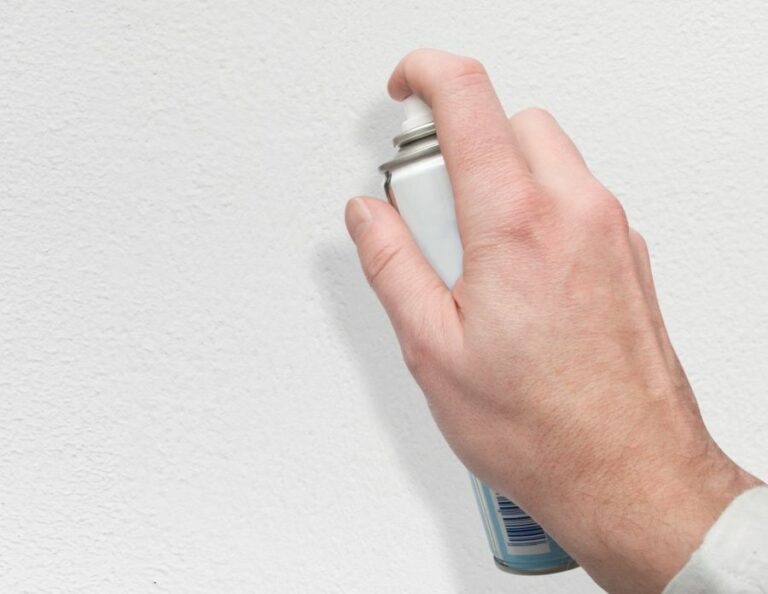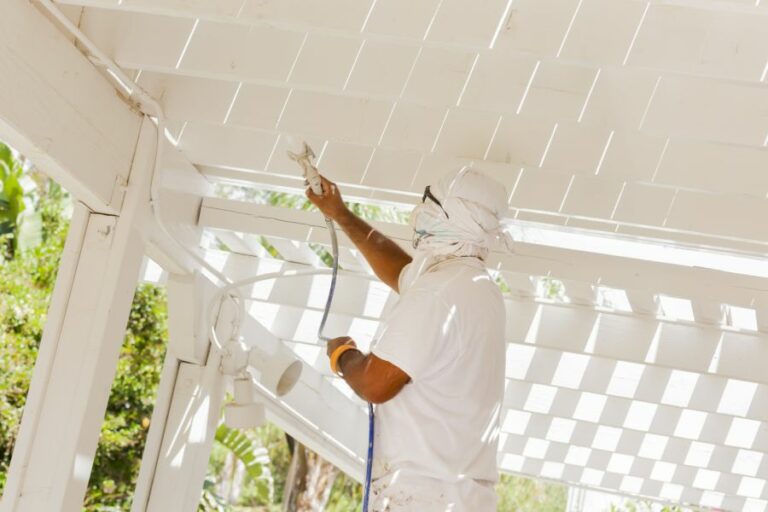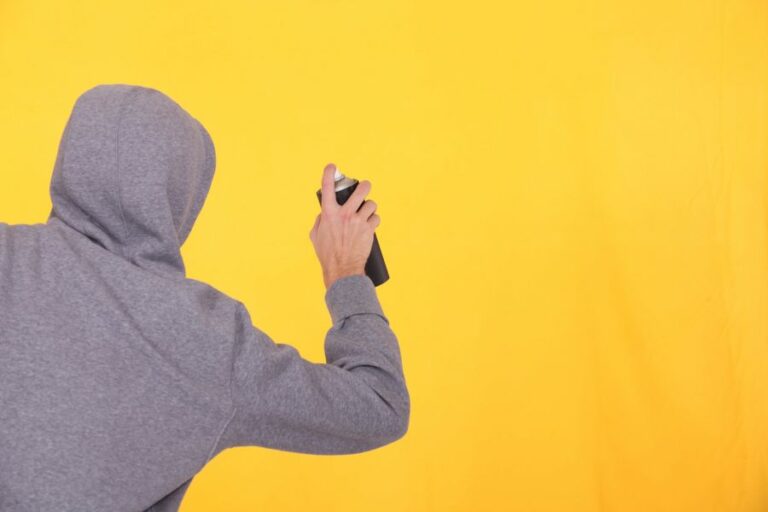Preserve Your Art: Spray Paint Maintenance & Care
As painters, we know that creating art is more than just a hobby; it’s a passion we want to preserve and showcase for years. If you’re a spray paint enthusiast like us, you understand the importance of maintaining and caring for your masterpieces all too well. We have gathered a wealth of knowledge on spray paint maintenance and care, ensuring that your art remains vibrant and protected against the tests of time.
Preserve your art: spray paint maintenance & care:
To preserve your spray paint art, understand its components, store your paints at proper temperatures (60-80°F or 16-27°C) away from sunlight, keep cans upright, rotate stock, and check seals. Perform regular maintenance like shaking cans, cleaning nozzles, and testing sprays. Practice proper techniques such as maintaining distance and applying thin, layered coats to maintain optimal paint performance and create exceptional artwork.

Looking to preserve the vibrancy of your spray paint artwork? We’ve got the tips and techniques to ensure your masterpiece remains in pristine condition. Learn proper maintenance, cleaning, and care to keep your art looking fresh. Read on to unlock these secrets!
Contents
- 1 Maintain & Protect Your Spray Paint Art: Essential Tips
- 2 Safeguarding Your Spray Paint Creations: A Guide
- 3 Enhancing the Longevity of Your Spray Paint Projects
- 4 Sealing Techniques for Spray Paint: A Necessary Step?
- 5 Understanding and Preventing Spray Paint Art Fading
Maintain & Protect Your Spray Paint Art: Essential Tips
• A Guide for the Passionate Artist
Art is a manifestation of one’s creativity, and spray paint is one medium that can bring this creativity to life. A good artist must understand that maintaining their spray paint is just as important as practicing their craft.
• Understanding Spray Paint Components
Spray paint is made up of four primary components, which greatly influence its performance:
- Pigments: These particles provide color and hiding power.
- Binders: Resins that bind pigments together and stick them to surfaces.
- Solvents: Liquids that dissolve pigments and binders and evaporate to dry the paint.
- Additives: Improve paint properties like flow, leveling, and drying time.
To maintain your spray paint, you must understand how these components affect its performance and what you need to do to ensure their quality remains intact. The Paint & Coatings Resource Center offers in-depth explanations of these components and their roles in paint formulations.
• Storage Makes a Difference
The way you store your spray paint plays a crucial role in preserving its quality. The following tips will help you store your spray paint so it remains in optimum condition:
– Proper Temperature
A key factor in storing spray paint is maintaining the right temperature. Most manufacturers recommend a storage temperature between 60°F and 80°F (16°C to 27°C). Temperatures outside this range can compromise the paint’s performance.
– Avoid Direct Sunlight
Direct sunlight can also adversely affect your spray paint, causing the color to fade and the paint to degrade. Store your paints in a cool, dark place away from windows and natural light.
– Keep it Upright
Always store spray paint cans upright. This helps keep the mixing ball and paint contents in contact, ensuring the paint remains evenly mixed.
– Rotate Your Stock
As with most consumables, spray paint has a shelf life. Make sure to rotate your stock, using the oldest cans first. This ensures you’re always using the freshest paint possible.
– Check Seals
Ensure the can’s nozzle and cap are sealed correctly after each use. This prevents solvents from evaporating and keeps the paint in optimum condition.
• Regular Maintenance
To preserve the performance of your spray paint, it’s essential to perform regular maintenance tasks. These steps will help you achieve consistent results and prolong the life of your cans:
– Pre-Use Shake
Before using a spray paint can, give it a vigorous shake for at least two minutes. This ensures the pigments, binders, solvents, and additives are mixed thoroughly.
– Clean Your Nozzles
After each use, remove the nozzle and clean it using a solvent like acetone or paint thinner. This prevents paint build-up, keeping the nozzle clear and helping to avoid clogging or inconsistent spray patterns.
– Test Spray
Before committing to your art project, always perform a test spray on a piece of scrap material. This ensures the paint is mixing and flowing correctly and alerts you to any issues before they affect your work.
– Invert & Clear
After each use, invert the can and spray briefly to clear the nozzle of any remaining paint. This helps prevent clogging and ensures consistent performance.
– Don’t Sabotage Your Can
One common mistake is jamming objects like paperclips or needles into the nozzle to clear blockages. This can damage the nozzle and compromise your paint’s performance. Instead, try soaking the nozzle in solvent to dissolve any blockages.
• Practice Proper Technique
Lastly, using proper spray painting techniques helps preserve the life of your cans and ensures you produce high-quality artwork. Some key tips include:
– Distance Matters
Maintain an appropriate distance from the surface you’re painting; 10 to 12 inches is usually ideal. This helps achieve a consistent, even application and avoids overspray.
– Smooth Motions
Use smooth, sweeping motions when spray painting. This helps achieve even coverage and reduces the risk of drips or runs.
– Layering & Drying
Apply thin layers of paint, allowing each layer to dry before adding more. This encourages even coverage and reduces the risk of paint cracking or peeling.
By understanding the components of spray paint, ensuring proper storage, performing regular maintenance, and practicing good technique, you can preserve your art and keep your spray paint in perfect working condition.
With these measures in place, you can continue to create exceptional art that showcases your talent and passion. So, the next time you pick up a can of spray paint, remember to follow these steps and enjoy a satisfying artistic experience.
Safeguarding Your Spray Paint Creations: A Guide
Spray paint art is a popular and vibrant medium that can bring life to a diverse range of projects, from large-scale murals and street art to smaller canvas pieces.
However, with its unique material properties, spray paint also requires special attention to ensure its longevity and maintain its vibrant colors.
• Choosing the Right Spray Paint
First and foremost, the long-term durability of your artwork depends on selecting the proper spray paint products.
High-quality, artist-grade spray paint specifically designed for your chosen surface will ensure the paint adheres well and lasts a long time.
Brands such as Montana, Liquitex, and Ironlak offer a wide variety of spray paints that cater to different artistic needs.
• Preparing the Surface
Before you start spray painting, it’s essential to prepare your work surface to create a strong bond between the paint and the material. Proper surface preparation will prevent peeling, chipping, and fading over time.
– Priming
Priming creates a uniform and stable foundation for your spray paint. For canvas, wood, metal, or other porous surfaces, use a specialized primer (e.g., Gesso for canvas or a metal primer for metal surfaces) before applying spray paint.
– Cleaning
Dirt, dust, or any other contaminants can prevent proper paint adhesion. Ensure that your surface is clean and dry before spray painting. You can use mild soap, water, and a soft cloth to clean the surface, followed by a thorough drying.
• Using Proper Technique
An even application of spray paint is crucial to achieve a durable painted surface. It can avoid uneven coverage, drips, and pooling, which can lead to paint chipping or peeling over time. A few tips for proper spray paint application include:
- Shake the spray paint can well before application;
- Hold the can at a distance of 8-12 inches from the surface;
- In a sweeping motion, apply thin coats of paint, overlapping each pass slightly;
- Allow enough time for paint layers to dry before applying a new coat.
• Sealing and Protecting the Artwork
Once you have finished spray painting your art, it’s vital to provide a protective layer to prevent damage and fading due to exposure to environmental factors.
– Clear Coating
A clear coat can enhance the color and sheen of your artwork and, importantly, protect it from UV rays, moisture, scratches, and other surface damage.
Use a clear varnish, lacquer, or UV protectant spray specifically designed for your type of spray paint and work surface. Apply multiple thin coats following the manufacturer’s instructions.
– Framing and Display
When displaying your spray paint art, consider using UV-resistant glass or acrylic in the frame to minimize UV exposure.
Additionally, be mindful of the location when hanging your artwork – avoid direct sunlight, humidity, or areas where temperatures can fluctuate, such as near heating and cooling vents or windows.
• Proper Storage and Handling
When storing or transporting your spray paint art, take the necessary precautions to avoid damage:
- Place a sheet of acid-free paper or glassine paper between your art and any other surfaces;
- Store unframed artwork in a rigid, flat container to prevent bending, creasing or folding;
- Avoid stacking artwork directly on top of each other; use padding or separators between each piece.
• Maintenance and Cleaning
Finally, regular maintenance and cleaning will help keep your artwork looking its best. Gently clean the surface with a soft, damp cloth or a specialty art cleaning product, avoiding abrasive cleaners or chemicals that can damage the paint or protective seals.
By following these steps and recommendations, you can ensure that your spray paint art will remain vibrant and protected for years to come.
Step | Description |
|---|---|
1 | Allow the artwork to dry completely. This may take anywhere from a few hours to a couple of days, depending on the thickness of the paint layers. |
2 | Clean the surface of the artwork gently with a soft cloth to remove dust or debris. |
3 | Apply a clear coat or varnish. Choose a protective clear coat or varnish that is compatible with spray paint, such as a clear acrylic or enamel spray. |
4 | Apply the clear coat according to the manufacturer’s instructions, usually in thin, even layers. Make sure to cover the entire surface of the artwork. |
5 | Allow the clear coat to dry completely. This may take several hours or even days, depending on the product used. |
6 | Store or display the artwork in a suitable environment, away from direct sunlight, heat, and humidity, to prolong its lifespan. |
Enhancing the Longevity of Your Spray Paint Projects
Spray paint is an incredibly versatile medium, allowing artists, DIY enthusiasts, and professionals alike to achieve smooth, clean results on a variety of surfaces.
However, many users face the frustration of their spray paint losing its effectiveness or drying up too quickly. Here’s a comprehensive guide on making your spray paint last longer, ensuring that your projects look their best for years to come.
• 1. Properly Store Spray Paint
To keep spray paint fresh and ensure it lasts longer, proper storage is essential. Store cans in a cool, dry place, away from extreme temperatures or direct sunlight. Keep them away from open flames or heat sources, as spray paint is highly flammable.
Also, storing cans vertically, with the nozzles facing up, will prevent the paint from settling or thickening over time. For an excellent guide on proper spray paint storage, visit Artisan Central’s comprehensive article from the National Endowment for the Arts.
• 2. Shake the Can Thoroughly
Before using your spray paint, it is crucial to shake the can well for at least a minute. Shaking the can helps mix the paint pigments and solvents evenly, ensuring a smooth, long-lasting finish.
• 3. Clean and Prime the Surface
One of the keys to making spray paint last longer is proper surface preparation. First, clean the surface to remove any dirt, grease, or dust that may interfere with paint adhesion. Use a mild soap and water solution and a clean cloth, then rinse the surface with clean water and allow it to dry completely.
Next, applying a primer before your spray paint is crucial, especially on porous or uneven surfaces. Primers promote better adhesion and help create a barrier between the surface and the paint, prolonging the life of your paint job.
• 4. Use the Right Spray Paint for the Surface
Be sure to use the correct spray paint for your project, as different materials require specialized paints for proper adhesion and durability. Check the label on your spray paint can for the manufacturer’s recommendations on suitable surfaces.
For example, if you’re painting metal, use a paint specifically designed for metal surfaces. Similarly, use a paint formulated for plastic if you’re painting a plastic surface. This tailored approach will ensure that the paint lasts longer and doesn’t peel or crack.
• 5. Use Proper Spray Painting Techniques
Achieving a long-lasting spray paint finish requires proper application techniques. Keep these pointers in mind when applying spray paint:
- Maintain a consistent distance: Spray from about 10-12 inches away from the surface, maintaining a consistent distance as you move across it.
- Apply multiple thin coats: Rather than one thick coat, apply several thin coats to achieve better coverage and a smoother finish. Allow each coat to dry as per the manufacturer’s guidelines before applying the next.
- Use a sweeping motion: Move the can in a steady, sweeping motion as you apply the spray paint. This helps prevent paint buildup or drips, which can negatively affect the longevity of the paint job.
• 6. Protect Your Newly-Painted Surface
Once your paint job is complete, protect it from wear and tear by applying a clear topcoat or varnish. This not only seals and protects your paint but also adds a layer of UV resistance, which is particularly useful for outdoor projects.
Choose a topcoat that’s appropriate for the surface you painted and compatible with the type of spray paint you used. Follow the manufacturer’s instructions for the proper application of the topcoat.
• 7. Regular Maintenance
After you have completed your spray paint project, regular maintenance is crucial to preserve its appearance and longevity. Take the following steps to keep your painted surfaces looking fresh:
- Clean the surface regularly with a mild soap and water solution, avoiding abrasive cleaning tools that may damage the paint.
- Inspect the paint job frequently for signs of wear, chipping, or peeling. If you notice any issues, promptly clean and touch up the area to prevent further degradation.
- For outdoor projects, periodically check for UV damage or fading due to sun exposure. Address these issues by applying a new UV-resistant topcoat when needed.
By following these expert tips, you can significantly extend the life of your spray paint projects, ensuring they look great and last longer. By focusing on proper storage, surface preparation, application techniques, and maintenance, you will enjoy the benefits of a durable, long-lasting spray paint finish.
Step | Description |
|---|---|
1 | Choose the right spray paint for your project. |
2 | Prepare the surface properly by cleaning it and removing any dust, dirt, or grease. |
3 | Apply a primer if necessary to ensure better adhesion of the spray paint to the surface. |
4 | Apply thin, even coats of spray paint, allowing each coat to dry completely before applying the next. |
5 | Store the spray can properly when not in use. Keep it in a cool, dry place and away from direct sunlight or heat. |
6 | Use the entire can within a short period of time to prevent the paint from drying out and becoming less effective. |
Sealing Techniques for Spray Paint: A Necessary Step?
When undertaking a painting project, you might wonder whether you need to seal after using spray paint. In this comprehensive guide, we will explore the reasons why sealing is essential, the types of sealants available, and the steps to follow when applying them.
• Importance of Sealing Spray Painted Surfaces
Sealing a surface after spray painting provides several benefits, including:
– Protection from External Elements
A sealant forms a protective layer on the surface, guarding it against dust, dirt, moisture, and other elements that could potentially damage the paint or cause it to fade.
– Enhanced Durability
Sealing increases the longevity of the spray-painted surface. In the case of outdoor items exposed to the elements, a suitable sealant will protect the paint from UV rays, rainfall, and other environmental factors.
– Improved Visual Appeal
Applying a sealant can give the painted surface a glossy, smooth, and more professional-looking finish.
– Prevention of Paint Chipping
Sealants can help prevent paint from chipping or peeling, maintaining the appearance and quality of the surface.
• Types of Sealants
There are various types of sealants available, each with specific properties making them suitable for different spray-painting applications.
– Clear Acrylic Sealers
Clear acrylic sealers are versatile, ensuring protection while not altering the color or appearance of the spray-painted surface. This type of sealer is ideal for paintings, furniture, and other items that necessitate a transparent protective coat.
– Polyurethane (PU) Sealers
Polyurethane sealers are highly durable, providing excellent protection against wear, water, and chemicals. They are available in various finishes, including matte, semi-gloss, and high-gloss options. These sealants are ideal for wooden surfaces, such as furniture and doors.
– Spar Urethane
Spar Urethane sealants are specifically formulated for outdoor surfaces exposed to harsh environmental conditions. Their unique properties provide protection against water, UV rays, and temperature fluctuations. These sealants are ideal for wooden patio furniture, fences, and other outdoor projects.
– Epoxy Resin
Epoxy resin sealants create a durable, glossy, and protective finish on a wide range of surfaces. However, these sealants can turn yellow over time when exposed to sunlight, so they are primarily recommended for indoor projects.
• Steps to Seal Spray Painted Surfaces
– Step 1: Choose the Right Sealant
First, you must select a sealant that is compatible with the paint you used and suitable for your specific project. Always read the product labels and verify that the sealer is compatible with your paint type and surface.
– Step 2: Proper Preparation
After your spray paint has dried thoroughly, you must clean the surface to ensure a flawless sealant application. Gently wipe the surface with a cloth or soft brush to remove any dust, dirt, or debris.
– Step 3: Read and Follow the Instructions
Every sealant has its application instructions, which you should read and follow closely. This may include information about the number of coats, drying times, and tools needed.
– Step 4: Apply the Sealant
Apply the sealant in a well-ventilated area, wearing appropriate safety gear such as gloves and a mask. Using smooth, even strokes, apply the sealant in thin layers. Multiple thin coats provide better protection than a single, thick coat.
– Step 5: Allow for Drying Time
Let each coat dry as per the product’s instructions before applying the next layer. The number of coats necessary will depend on the sealant and the intended use of the finished item.
– Step 6: Clean Up and Dispose
Follow the manufacturer’s guidelines for cleaning your tools and disposing of any leftover sealant responsibly.
• Additional Recommendations
- Always perform a small test on an inconspicuous area or a sample piece to ensure compatibility and desired appearance before applying the sealant to the entire surface.
- To ensure optimal adhesion between the paint and the sealant, it’s essential to allow the paint to cure fully before applying the sealant. Consult the paint manufacturer’s guidelines for curing times.
In conclusion, sealing after spray painting is an essential step to enhance the durability, appearance, and protection of your painted projects. By choosing the suitable sealer and following the correct application process, you can ensure the best possible results for your spray-painted surfaces.
Factors | Sealing after Spray Paint: Yes or No? |
|---|---|
Surface material | Depends on the material being painted – some materials might require sealing for better protection, while others may not need it. |
Environmental conditions | Sealing can be beneficial when the painted item is exposed to harsh weather conditions or heavy wear and tear. |
Type of spray paint used | Some spray paints include built-in sealants. In such cases, no additional sealing is required. |
Desired finish | Sealing can provide a glossy or matte finish, depending on the sealant used. If a specific finish is desired, sealing may be necessary. |
Understanding and Preventing Spray Paint Art Fading
Spray paint art, like any other form of artwork, is prone to fading over time. However, the longevity and vibrancy of the colors used in spray painting depend on a variety of factors.
• The Factors Leading to Fading in Spray Paint Art
– Exposure to Sunlight
One of the primary reasons for fading in spray paint art is exposure to sunlight, particularly ultraviolet (UV) rays. UV radiation can cause pigments within spray paint to break down, resulting in fading or color shift.
This is why artwork exposed to direct sunlight or an outdoor environment for an extended period may lose its vibrancy.
– Quality of Spray Paint
The quality of the spray paint used plays a crucial role in the longevity and resistance to fading. High-quality paints that use pigments with superior lightfastness will prove to be more resistant to fading over time.
On the other hand, low-quality or budget spray paints may fade more rapidly due to their use of inferior pigments.
– Surface Preparation and Application Technique
The surface on which the spray paint is applied, as well as the artist’s application technique, can influence the fading tendency of the artwork.
Properly preparing surfaces, such as cleaning and priming, can provide a better base for the spray paint to adhere to, which may reduce the risk of fading.
• The Role of Quality Materials in Preventing Fading
– Spray Paint Selection
Using high-quality spray paint brands, such as Montana Gold or Liquitex, can provide better performance concerning fading. These brands often use high-quality pigments, which offer better lightfastness and longevity.
Refer to the manufacturer’s information regarding the lightfastness ratings of their spray paint products to make ideal choices.
– Surface and Primer Selection
The surface on which the spray paint is applied should also be considered when attempting to prolong and preserve the artwork. Materials such as wood, metal, or canvas that have been properly prepared and primed will provide a better foundation for the paint, enhancing its longevity.
• Preventive Measures to Protect Spray Paint Art from Fading
– Using UV-Resistant Varnish
One of the most effective ways to protect spray paint art from fading is to apply a UV-resistant varnish. These protective coatings can block or filter out damaging UV rays, thereby preventing the breakdown of pigments in the spray paint.
Varnishing will not only protect the artwork from fading but can also provide a degree of resistance to dirt, moisture, and other environmental factors.
– Displaying Artwork Indoors, Away from Direct Sunlight
To protect spray paint artwork from fading, displaying the work indoors and away from direct sunlight is recommended. Reducing the amount of UV radiation exposure can minimize the risk of fading, thus preserving the artwork’s original vibrancy for a longer time.
– Proper Storage of Spray Paint Art
Storing unused spray paint cans and spray-painted artwork in a cool, dry place away from sunlight, humidity, and temperature fluctuations is another preventive measure that can help in prolonging the life of the spray paint and keep the artwork from fading.
• Restoring Faded Spray Paint Artwork
In cases where a spray paint artwork has already faded, restoration may be possible. Seeking the help of a professional conservator or restoration artist who specializes in spray paint art can assess the proper course of action based on the severity of the fading and the artwork’s materials.
Additionally, artists with enough experience and confidence may attempt the restoration process themselves, taking necessary precautions and using appropriate methods.
In conclusion, while spray paint art has the potential to fade over time, using quality materials, making informed choices on surfaces and paints, and taking preventive measures can help protect the artwork and maintain its vibrancy for an extended period.
Remember to consult the manufacturer’s information on lightfastness and consider utilizing UV-resistant varnishes for added protection. By practicing good care and maintenance, you can keep your spray paint artwork looking vibrant and beautiful for years.







